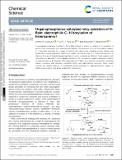Organophosphorus-catalyzed relay oxidation of H-Bpin: electrophilic C–H borylation of heteroarenes
Author(s)
Lipshultz, Jeffrey M; Fu, Yue; Liu, Peng; Radosevich, Alexander T
DownloadPublished version (846.0Kb)
Publisher with Creative Commons License
Publisher with Creative Commons License
Creative Commons Attribution
Terms of use
Metadata
Show full item recordAbstract
© The Royal Society of Chemistry 2020. A nontrigonal phosphorus triamide (1, P{N[o-NMe-C6H4]2}) is shown to catalyze C-H borylation of electron-rich heteroarenes with pinacolborane (HBpin) in the presence of a mild chloroalkane reagent. C-H borylation proceeds for a range of electron-rich heterocycles including pyrroles, indoles, and thiophenes of varied substitution. Mechanistic studies implicate an initial P-N cooperative activation of HBpin by1to giveP-hydrido diazaphospholene2, which is diverted by Atherton-Todd oxidation with chloroalkane to generateP-chloro diazaphospholene3. DFT calculations suggest subsequent oxidation of pinacolborane by3generates chloropinacolborane (ClBpin) as a transient electrophilic borylating species, consistent with observed substituent effects and regiochemical outcomes. These results illustrate the targeted diversion of established reaction pathways in organophosphorus catalysis to enable a new mode of main group-catalyzed C-H borylation.
Date issued
2021Department
Massachusetts Institute of Technology. Department of ChemistryJournal
Chemical Science
Publisher
Royal Society of Chemistry (RSC)
Citation
Lipshultz, Jeffrey M, Fu, Yue, Liu, Peng and Radosevich, Alexander T. 2021. "Organophosphorus-catalyzed relay oxidation of H-Bpin: electrophilic C–H borylation of heteroarenes." Chemical Science, 12 (3).
Version: Final published version